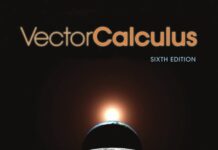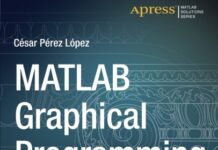| Book Name: | Numerical Linear Algebra with Applications Using MATLAB |
| Category: | MATLAB |
| Language: | English |
| Format: | |
| Free Download: | Available |
Numerical Linear Algebra with Applications Using MATLAB by William Ford | PDF Free Download.
| Book Details : | |
|---|---|
| Language | English |
| Pages | 629 |
| Format | |
| Size | 5.31 MB |
Numerical Linear Algebra with Applications Using MATLAB
Book Description:
Designed for those who want to gain practical knowledge of modern computational techniques for the numerical solution of linear algebra problems, Numerical Linear Algebra with Applications contains all the material necessary for a first year graduate or advanced undergraduate course on numerical linear algebra with numerous applications to engineering and science.
With a unified presentation of computation, basic algorithm analysis, and numerical methods to compute solutions, this book is ideal for solving real-world problems. It provides necessary mathematical background information for those who want to learn to solve linear algebra problems, and offers a thorough explanation of the issues and methods for practical computing, using MATLAB as the vehicle for computation. The proofs of required results are provided without leaving out critical details. The Preface suggests ways in which the book can be used with or without an intensive study of proofs.
Six introductory chapters that thoroughly provide the required background for those who have not taken a course in applied or theoretical linear algebra
Detailed explanations and examples
A through discussion of the algorithms necessary for the accurate computation of the solution to the most frequently occurring problems in numerical linear algebra
Examples from engineering and science applications
Numerical Linear Algebra Contents
- Matrices
- Linear Equations
- Subspaces
- Determinants
- Eigenvalues and Eigenvectors
- Orthogonal Vectors and Matrices
- Vector and Matrix Norms
- Floating-Point Arithmetic
- Algorithms
- Conditioning of Problems and Stability of Algorithms
- Gaussian Elimination and the LU Decomposition
- Linear System Applications
- Important Special Systems
- Gram-Schmidt Orthonormalization
- The Singular Value Decomposition
- Least-Squares Problems
- Implementing the QR Decomposition
- The Algebraic Eigenvalue Problem
- The Symmetric Eigenvalue Problem
- Basic Iterative Methods
- Krylov Subspace Methods
- Large Sparse Eigenvalue Problems
- Computing the Singular Value Decomposition
Preface to Numerical Linear Algebra with Applications Using MATLAB
This book is intended for an advanced undergraduate or a first-year graduate course in numerical linear algebra, a very important topic for engineers and scientists.
Many of the numerical methods used to solve engineering and science problems have linear algebra as an important component.
Examples include spline interpolation, estimation using least squares, and the solution of ordinary and partial differential equations. It has been said that, next to calculus, linear algebra is the most important component in engineering problem-solving.
In computer science, linear algebra is critical as well. The Google matrix is an example, as is computer graphics where matrices are used for rotation, projection, rescaling, and translation. Applications to engineering and science are provided throughout the book.
Two important problems in a customary applied linear algebra course are the solution of general linear algebraic systems Ax = b, where A is an m × n matrix, and the computation of eigenvalues and their associated eigenvectors.
Suppose the system is square (m = n) and nonsingular. In that case, the student is taught how to find a solution to Ax = b using Cramer’s Rule, Gaussian elimination, and multiplication by the inverse. In many areas of application, such as statistics and signal processing,
A is square and singular or m = n. In these situations, the transformation to a reduced row-echelon form produces no solution or infinitely many, and this is just fine in a theoretical sense but is not helpful for obtaining a useful solution.
Eigenvalues are often discussed late in the course, and the student learns to compute eigenvalues by finding the roots of the characteristic polynomial, never done in practice. A study of numerical linear algebra is different from a study of linear algebra.
The problem is that many of the theoretical linear algebra methods are not practical for use with a computer.
To be used on a computer, an algorithm, a method for solving a problem step by step in a finite amount of time, must be developed that deals with the advantages and problems of using a computer.
Any such algorithm must be efficient and not use too much computer memory. For instance, Cramer’s Rule is not practical for matrices of size 4 × 4 or greater, since it performs far too many operations. Since a digital computer performs arithmetic in binary with a fixed number of digits, errors occur when entering data and performing computations.
For instance, 1/3 cannot be represented exactly in binary, and its binary representation must be approximated. In addition, computation using the operations of addition, subtraction, multiplication, and division rarely can be done exactly, resulting in errors.
An algorithm must behave properly in the presence of these inevitable errors; in other words, small errors during computation should produce small errors in the output.
For example, the use of Gaussian elimination to solve an n×n linear system should use a method known as partial pivoting to control errors.
When the matrix A is m×n, m = n, a solution must be obtained in the sense of least-squares, and the efficient and implementation of least-squares presents challenges. The eigenvalue problem is of primary importance in engineering and science.
In practice, eigenvalues are not found by finding the roots of a polynomial, since polynomial root finding is very prone to error. Algorithms have been developed for the accurate solution of the eigenvalue problem on a computer.
In the book, algorithms are stated using pseudocode, and MATLAB is the vehicle used for algorithm implementation. MATLAB is superb in dealing with numeric computation and is used in most engineering programs.
Accompanying the text is a library of MATLAB functions and programs, named NLALIB, that implements most of the algorithms discussed in the book. Many examples in the book include computations using MATLAB, as do many exercises.
In some cases, a problem will require the student to write a function or program using the MATLAB programming language. If the student is not familiar with MATLAB or needs a refresher, the MathWorks Web site www.mathworks.com provides access to tutorials.
There are also many free online tutorials. If the reader cannot access MATLAB, it is possible to use GNU Octave, a system primarily intended for numerical computations. The Octave language is quite similar to MATLAB so that most programs are easily portable.
This book is novel, in that there is no assumption the student has had a course in linear algebra. Engineering students who have completed the usual mathematics sequence, including ordinary differential equations, are well prepared.
The prerequisites for a computer science student should include at least two semesters of calculus and a course in discrete mathematics.
Chapters 1-6 supply an introduction to the basics of linear algebra. Thorough knowledge of these chapters prepares the student very well for the remainder of the book. If the student has had a course in applied or theoretical linear algebra, these chapters can be used for a quick review. Throughout the book, proofs are provided for most of the major results.
In proofs, the author has made an effort to be clear, to the point of including more detail than normally provided in similar books.
It is left to the instructor to determine how much emphasis should be given to the proofs. The exercises include routine pencil and paper computations. Exercises of this type force the student to understand the workings of an algorithm better.
There are some exercises involving proof. Hints are provided if a proof will be challenging for most students. In the problems for each chapter, there are exercises to be done using MATLAB.
Download Numerical Linear Algebra with Applications: Using MATLAB PDF
Author(s): William Ford
Publisher: Academic Press, Year: 2014
ISBN: 012394435X,9780123944351
Download Numerical Linear Algebra with Applications Using MATLAB in PDF Format For Free.









![[PDF] Draw Buildings and Cities in 15 Minutes Draw Buildings and Cities in 15 Minutes pdf](https://www.freepdfbook.com/wp-content/uploads/2021/06/Draw-Buildings-and-Cities-in-15-Minutes-218x150.jpg)








![[PDF] Digital Image Processing An Algorithmic Introduction Using Java Digital Image Processing An Algorithmic Introduction Using Java](https://www.freepdfbook.com/wp-content/uploads/2022/06/Digital-Image-Processing-An-Algorithmic-Introduction-Using-Java.jpg)




![[PDF] 43 Years JEE ADVANCED + JEE MAIN Chapterwise & Topicwise Solved Papers 43 Years JEE ADVANCED (1978-2020) + JEE MAIN Chapterwise & Topicwise Solved Papers Physics PDF](https://www.freepdfbook.com/wp-content/uploads/2022/03/43-Years-JEE-ADVANCED-1978-2020.jpg)

![[PDF] Problems in Physical Chemistry for JEE (Main & Advanced) Problems in Physical Chemistry for JEE (Main & Advanced) Free PDF Book Download](https://www.freepdfbook.com/wp-content/uploads/2022/03/Problems-in-Physical-Chemistry-for-JEE-Main-Advanced.jpg)
![[PDF] Engineering Physics (McGraw Hill)](https://www.freepdfbook.com/wp-content/uploads/2021/05/bafc8c2685bb6823a9c56134f7fba5df.jpeg)

![[PDF] Engineering Chemistry By Shashi Chawla](https://www.freepdfbook.com/wp-content/uploads/2022/05/Theory-And-Practicals-of-Engineering-Chemistry-By-Shashi-Chawla-free-pdf-book.jpeg)
![[PDF] Chemistry: An Introduction to Organic, Inorganic & Physical Chemistry Chemistry: An Introduction to Organic, Inorganic & Physical Chemistry](https://www.freepdfbook.com/wp-content/uploads/2022/04/Chemistry-An-Introduction-to-Organic-Inorganic-Physical-Chemistry.jpg)
![[PDF] Essentials of Physical Chemistry Essentials of Physical Chemistry Free PDF Book by Bahl](https://www.freepdfbook.com/wp-content/uploads/2022/04/Essentials-of-Physical-Chemistry-bahl.jpg)
![[PDF] Biological control of plant-parasitic nematodes: soil ecosystem management in sustainable agriculture Biological control of plant-parasitic nematodes: soil ecosystem management in sustainable agriculture](https://www.freepdfbook.com/wp-content/uploads/2022/05/Biological-control-of-plant-parasitic-nematodes-soil-ecosystem-management-in-sustainable-agriculture.jpg)
![[PDF] Human Anatomy: Color Atlas and Textbook Human Anatomy: Color Atlas and Textbook Free PDF Book](https://www.freepdfbook.com/wp-content/uploads/2022/05/Human-Anatomy-Color-Atlas-and-Textbook.jpg)
![[PDF] Concepts of Biology Book [Free Download]](https://www.freepdfbook.com/wp-content/uploads/2022/05/Concepts-of-Biology.jpg)
![[PDF] Essentials of Biology [Free Download] Essentials of Biology Free PDF BOok Download](https://www.freepdfbook.com/wp-content/uploads/2022/05/Essentials-of-Biology-Free-PDF-Book-Downlaod.jpg)
![[PDF] Human Biology Book [Free Download]](https://www.freepdfbook.com/wp-content/uploads/2022/05/PDF-Human-Biology-Book-Free-Download.jpg)


